Abstract
Increasing the load demand and penetration of renewable energy sources (RESs) poses real challenges for optimal energy management of distribution networks. Moreover, considering multi-carrier energy systems has increased the efficiency of systems, and provides an opportunity for using the advantages of RESs. In this regard, we adopted a new framework based on the new challenges in the multi-carrier energy micro-grid (MEMG). In the proposed method, a comprehensive MEMG was modeled that benefits from a large assortment of distributed energy resources (DERs), such as micro-turbines, fuel cells, wind turbines, and energy storage. Considering many DERs is necessary, because these resources could cover one another’s disadvantages, which have a great impact on the total cost of the MEMG and decrease the emission impacts of fossil-fuel-based units. Furthermore, waste power plants, inverters, rectifiers, and emission constraints are considered in the proposed method for modeling a practical MEMG. Additionally, for modeling the uncertainty of stochastic parameters, a model based on a multilayer neural network was used in this paper. The results of this study indicate that using a decentralized model, along with stochastic methods for predicting uncertainty, can reduce operational costs in micro-grids and computational complexity compared with optimal centralized programming methods. Finally, the equations and results obtained from the proposed method were evaluated by experiments.
1. Introduction
With the increasing need for electricity and the problems associated with centralized fossil fuel power plants—such as environmental pollution, exorbitant construction and maintenance costs, etc.—the use of MEMGs is a good solution; they allow the extensive utilization of renewable energies, distributed energy resources (DERs), and participation of consumers in the optimal management of power system operation, and using these systems can play a vital role in optimal energy consumption, system stability, and system reliability [1,2,3,4]. Furthermore, renewable energy sources have high uncertainty and an intermittent nature [5,6,7,8]. One solution to this problem is the micro-grid, which facilitates the response to load demand [9,10,11,12].
In terms of operation, micro-grid energy management systems (MEMSs) can be divided into centralized and decentralized (distributed) perspectives [13]. In centralized approaches, a central agent, which can process large amounts of data, is needed in order to gather information from other agents [14]. In multi-carrier micro-grids with distributed energy management, the privacy of agents is preserved. Moreover, each independent agent can optimize its costs in a parallel or sequential manner [15]. Providing an optimal approach to planning of system components is very important. The network used in this research consisted of micro-turbines, waste power plants, fuel cells, wind turbines, boilers, anaerobic reactors, inverters, rectifiers, and some energy storage units. It is also possible to exchange information between different levels of the system. This feature increases the reliability of the system and, compared with non-participating systems, achieves a better result. In this research, we sought to find the optimal performance strategy for system components, while meeting the electrical and thermal needs of customers. The micro-grid system is capable of exchanging electricity with high energy levels, as well as daily component performance scheduling.
The rest of this paper is organized as follows: In Section 2, a review of the related work, along with a description of the proposed methodology of this research, is provided. Section 3 presents the proposed MEMG structure. In Section 4, agents are modeled. In Section 5, the simulation of the proposed method to achieve optimal performance of MEMG agents is performed. Section 6 presents the simulation results, and we review the obtained results with different criteria and compare them with other methods in order to validate the proposed method.
2. Literature Review
In energy management systems with a single energy carrier, optimal performance and calculations are simpler, due to the lack of independence among energy carriers. Some research has been done to optimize the performance of such systems based on time-series analysis, factor-based optimization algorithms, etc. [16,17,18,19]. However, in a few cases, uncertainty in load demand is included in optimizing system performance. For example, in [20], the effect of the presence of DERs in optimizing the performance of energy management systems is investigated.
In multi-carrier energy management systems, computing and optimizing system performance is more complex. In [21], a model for optimizing the performance of the Poly Generation micro-grid of the University of Geneva is presented, showing that MEMGs can have economic and environmental benefits if they use the optimal strategy. Furthermore, in [22], an optimization model for a PG micro-grid in the presence of renewable energy sources is proposed. In [23], a real-time operational optimization method is presented. In [24,25,26], the problems of optimizing the performance of multi-carrier energy systems with centralized approaches, and from top to down, were investigated. On the other hand, in a few cases—such as [27,28]—the problems of optimal planning of the performance of the multi-carrier energy systems with decentralized and distributed approaches have been investigated.
Load demand is not considered in energy management systems with multiple energy carriers. The reasons for this include computational complexity, performance optimization of energy carriers, uncertainties in renewable energy production, and continuous fluctuation.
Hence, the authors of [27,28] could not consider the uncertainties. Considering uncertainties makes it difficult to provide an optimal approach but, on the other hand, it makes the optimal approach more efficient and reduces the operating costs of the system. In [29], optimization was achieved using PSO and GA to solve the problem of MEMG operational planning. Meanwhile, [30] used a stochastic model for electricity and natural gas pricing and load demand in real time. In [31], a micro-grid management approach is presented, considering random load and predicting the demand. In [26], a new method for a multi-agent system (MAS) is presented, which is a combination of ANFIS and GA.
In [15], deep learning is used to model uncertainties. In [32], optimization of the performance of the system is achieved using the gray wolf optimization method. In [33], the evolutionary vertical sequencing protocol is used to model coordination between high-level agents, and a two-layer MLIP is used for low-level uncertainty. In [34], micro-grid energy management with a decentralized approach is achieved using reinforcement learning. In [35], a game-theory-based optimization model is presented to configure the capacity of energy carrier agents.
In multi-carrier systems, providing an optimal approach is complex because, in such systems, uncertainties related to energy production in renewable sources, fluctuations in load demand, and uncertainty in market price exist. Reviewing the related work in energy management of multi-carrier energy networks indicates that such systems can reduce costs and pollution if optimally operated. Due to the importance of the optimal performance of MEMGs, studies in this field have been considered. However, most of these studies have not considered demand response programs and uncertainties related to the output of renewable energy. To overcome these limitations, this study presents a multi-carrier system (MCS) for planning the optimal performance of MEMG agents, considering uncertainties related to renewable energy production and energy demand fluctuations. The effect of using demand response programs is also presented, with the two objectives of minimizing operational and environmental costs. The efficiency of the proposed method is to simplify the complex MEMG model and reduce the calculations so as to apply uncertainty in the relationships of MG agents.
3. Introducing the Proposed System
As shown in Figure 1, the multi-agent combination, in which each agent performs its tasks to achieve the overall goal of the system, is called MCS. Generally, MCS is divided into three layers: upstream network, MG, and field, as shown in Figure 2. These three layers consist of eight agents. The agents are the upstream network, micro-grid, thermal, hydrogen, RB unit, renewable, storage, and load collector. The upstream grid agent is located in the first layer, which includes the natural gas grid and the electricity grid. This agent is used as an additional resource in case of a lack of energy production.
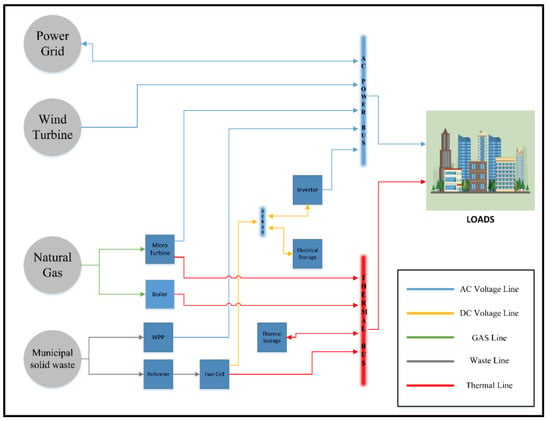
Figure 1.
Structure of the proposed MEMG.
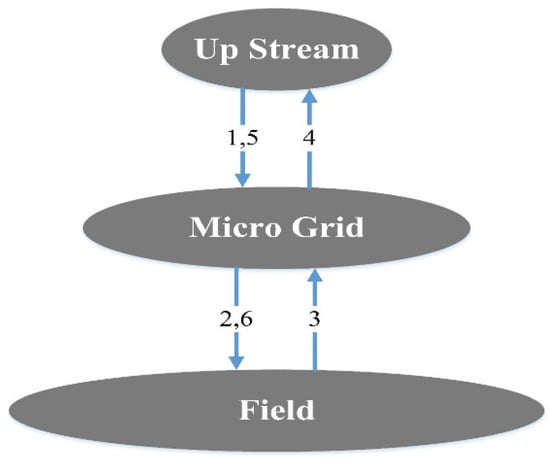
Figure 2.
Architecture of the MCS and date exchange.
The micro-grid agent is located in the second layer, which is responsible for coordinating the production and consumption of electrical and thermal energy. This task is performed under the optimal performance of agents while observing the constraints.
The other six agents associated with the production or consumption of electrical and thermal energy and hydrogen are located in the field layer. The overall structure of the proposed method of this study is shown in Figure 3. As shown in Figure 3, in the first step, we select the data related to wind speed and energy demand, and apply them to the LSTM block as input data. In the second step, using the recursive neural network (LSTM) method, we predict the diagrams related to electrical energy data of the wind turbine output, energy demand, and energy price. In the third step, we use a mixed-integer linear programming method and optimize the total cost function, while meeting the existing constraints. This step is carried out according to the modeling of MEMG agents, which is discussed in the next section. Moreover, uncertainty data are modeled with the LSTM block. In the fourth step, the optimal performance of each agent is determined, while minimizing the objective function.
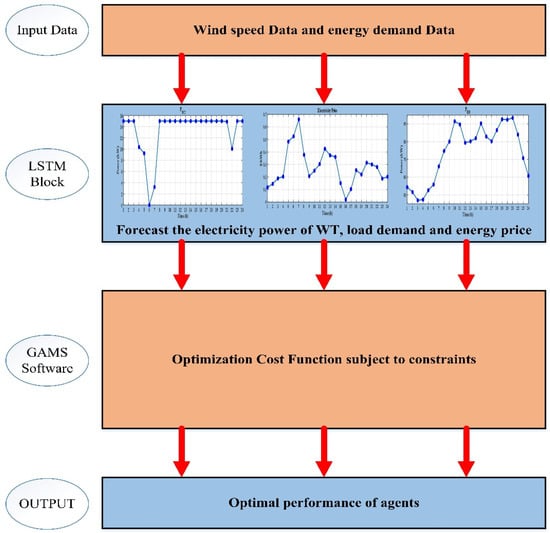
Figure 3.
The overall structure of the proposed method.
4. Modeling Agents
4.1. Upstream Network
This agent must announce the hourly price of buying and selling electricity and natural gas, as well as the constraints on energy exchange in the network of the micro-grid operator.
4.2. Micro-Grid Agent
This agent must transmit information about energy costs to field layer agents; it is also responsible for monitoring the optimal performance of field layer agents while observing the constraints imposed by the upstream network and reducing the operating costs of the micro-grid.
The electrical equilibrium equation is defined as follows:
The AC power in the inverter is calculated using Equation (4):
Additionally, the AC power in the rectifier is obtained from Equation (5).
The thermal equilibrium equation is also defined as follows:
The micro-grid agent checks the above equilibrium equations, and the system must operate in such a way that the above conditions are met.
The amounts of air pollutants emitted from the operation of micro-turbines, fuel cells, rubbish burning units, and the boiler in the micro-grid, in kg/kWh, are obtained from Equation (7):
Micro-grid performance must be optimized with the following constraints:
where is the maximum value of the pollutants, and is equal to 0.66 kg/kWh.
The objective function of total costs of the micro-grid is defined by the following equation:
It should be noted that the electrical power of micro-turbine agents, fuel cells, rubbish burning units, electrical storage agents, and are considered to be decision variables.
4.3. Thermal Agent
This agent consists of two parts: micro-turbine, and boiler. The equation of the electrical output power of micro-turbines is as follows:
Additionally, the thermal output power of the micro-turbine is proportional to the electric power, which is as given in Equation (11):
The thermal output power of the boiler is also given as Equation (12).
The costs of fuel, maintenance and repair, and switching on and off of the micro-turbine are also calculated by Equations (13)–(15), respectively.
The amounts of air pollutants produced by micro-turbines and boilers can be calculated through Equations (16) and (17), respectively.
4.4. Hydrogen Agent
This agent includes FC and HT; it must announce the characteristics of the above two parts to the micro-grid agent. Electric and thermal output power in FC is calculated by Equations (18) and (19), respectively.
Costs related to fuel consumption, maintenance, and turning on and off of the FC are formulated as in Equations (13)–(15). Moreover, the amount of air pollutants produced by FC is similar to that given in Equation (16), according to the specifications of the FC.
The amount of hydrogen stored in the hydrogen tank is formulated as follows (20):
where is the density of hydrogen, which is equal to 0.085 g/L. The constant is considered to be 142 MJ/Kg.
4.5. Rubbish Burning Agent
The rubbish burning agent includes the RB power plant; it is also responsible for announcing the status and characteristics of the RB power plant to the micro-grid operator. Moreover, the source of waste supply for this agent is municipal solid waste. The electrical output power of this unit is calculated using Equation (10). Furthermore, the costs of fuel consumption, maintenance and repair, and turning on and off of the RB unit are formulated according to Equations (13)–(15). The amount of pollutants produced by the RB power plant is similar to that given by Equation (16).
4.6. Renewable Agent
In recent years, artificial-intelligence-based methods have been known as a promising tool to model the different stochastic parameters, such as load demand, generation of renewable energy sources, and electric vehicle behavior [36,37]. In this paper, a method based on long short-term memory (LSTM) neural networks is used for modeling the stochastic parameters. The LSTM networks are very popular in time-series forecasting because they are robust against the vanishing gradient problem [38]. Interested readers are referred to [37,38] for more information about the LSTM network structure and its formulation.
4.7. Storage Agent
The storage agent must report the status and characteristics of the electrical and thermal storage units to the micro-grid agent. In this section, the amount of electric charge stored by the system is calculated using Equation (22):
The amount of heat stored by the system is also calculated with the same equation (Equation (22)). An equation similar to Equation (14) satisfies the maintenance and repair costs of the storage system.
4.8. Load Collector Agent
As a renewable agent for modeling the uncertainty of the load controller agent, an LSTM neural network was used.
4.9. Agents’ Connection
According to Figure 2, the communication between agents takes place in six steps. Figure 2 shows the sequence of information exchange in the proposed MCS. In Figure 2, the numbers indicate the sequence of messages. It should also be noted that messages are sent on an hourly basis. The connections between agents in the system are such that in the first step, the upstream network agent announces information about energy purchase costs and constraints to the micro-grid. In the second step, the micro-grid agent requests the status of the agents from the field layer agents; then, in the third step, the field layer agents respond to the micro-grid request. In the fourth step, the micro-grid agent sends the status of the energy shortage and the purchase request to the upstream network agent in order to return the confirmation of the purchase or sale of electricity to the micro-grid in the fifth step. Finally, in the sixth step, the micro-grid agent sends instructions related to the performance of the field agents to each agent.
4.10. LSTM
A recursive neural network (R-NN) is a modified version of conventional neural networks [39]. In deep R-NNs, the descriptive version of R-NNs, known as LSTM networks, can be used to solve the problem of gradient vanishing in hidden layers. In the mentioned LSTM, various operational gates are considered, as shown in Equations (23)–(27) [40].
where
and
[41].
5. Linearization
In this step, in order to reduce the computational costs and problem-solving time, we linearize the equations for modeling MEMG agents via the following methods:
- Linearizing by multiplying two binary variables u1, u2 [42]:So (28) will be linearized by (29).
- Linearizing by multiplying a binary variable u1 and a continuous variable x1 [43]:So (30) is linearized by the inequalities of (31).where M is a large constant;
- Linearizing quadratic cost function: To linearize quadratic cost function, we use the piecewise linear (P.W.L) method described in [44].
6. Simulation
To validate the proposed method, we used the proposed MCS method in the described MEMG. All simulations were conducted with an Intel® Core (TM) i7-10810u CPU with a frequency of 1.61 GHz and with GAMS software.
6.1. Input Data
In this research, information about uncertainties regarding wind turbine energy production as well as energy demand was predicted using the LSTM networks, as can be seen in the diagrams of Figure 4, Figure 5, Figure 6 and Figure 7. The data from Ontario province in Canada were used as input data for the LSTM network based on [45,46]. Hourly data on wind speed, electricity prices, and energy demand over three years from 1 January 2018 to 30 December 2020 were investigated. It should be noted that the energy price data are for Ontario in Canada. Given that retail prices are commonly used for MGs, the Ontario market price data were scaled at an appropriate rate. The specifications of the micro-turbines, fuel cells, boilers, and the waste power plant are shown in Table 1 [47,48]. Moreover, the total cost in Equation (9) is minimized by considering the constraints in the system with GAMES software and a mixed-integer linear programming method. The nonlinear form of the total cost equation makes the calculations difficult. Therefore, once the nonlinear equation is minimized, the total cost equation is first linearized, and then the minimization is carried out. Furthermore, to compare the proposed method and the validation of this method, we used a conventional centralized approach to optimize the performance of agents in order to reduce the initial costs of the MG. In the centralized method, uncertainties related to wind speed and the total energy demand are not considered, and the actual amount is not predicted.
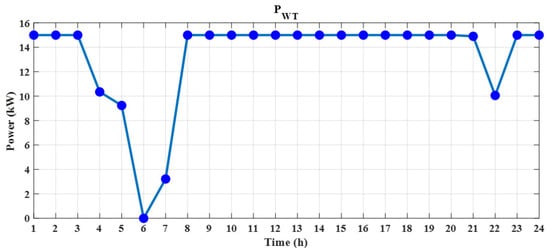
Figure 4.
Daily electric power generated by wind turbines.
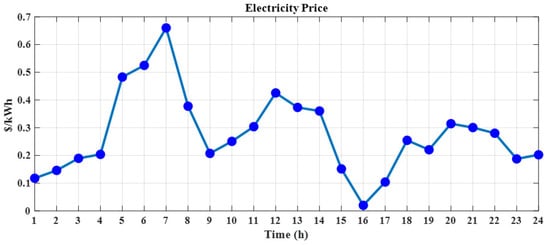
Figure 5.
Daily electricity prices.
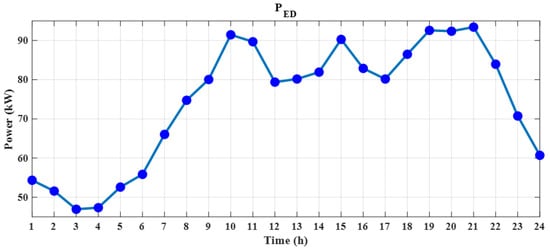
Figure 6.
Daily electricity load demand.
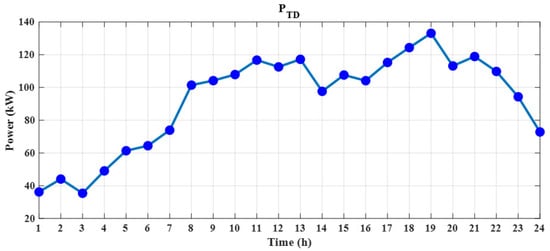
Figure 7.
Daily thermal load demand.

Table 1.
Specifications of the micro-turbine, fuel cell, boiler, and waste power plant.
6.2. Results
The results of the amounts of energy production or consumption in each of the network agents are shown in Figure 8 and Figure 9. To validate the proposed method, the optimization results in linear and nonlinear methods, as well as the common optimization method, are shown in Table 2, regardless of the uncertainties. As shown in Table 2, using the proposed method reduces MEMG operating costs by 34% compared to conventional centralized models. The USD 26.6 decrease is due to a reduction in the charge and discharge cycles (ES). According to the diagram in Figure 8, it is clear that the electrical energy exchanged between the MG and the upstream grid in one day is equal to 354.5 KW. Since power generation with an MG is always assumed to be cheaper than purchasing power from the upstream grid, micro-grids have reduced operating costs. On the other hand, according to the data in Table 1, the electrical energy produced in WPP is cheaper than the micro-turbines and FC units. According to Figure 8, it can be seen that the amount of electrical energy produced by the WPP is higher than the FC and micro-turbine units, which is also one of the reasons for reducing the cost of the MEMG. As shown in Figure 9, from points 2 to 6, the thermal energy produced by the FC and micro-turbine is more than the heat load, and the thermal storage system is charging. On the other hand, from points 9 to 13 and 16 to 22, since more heat load is generated and stored than thermal energy, the boiler responds to the heat load demand. Moreover, the use of the proposed method reduces the emission of pollutants by the micro-turbine, RB, FC, and boiler compared to the conventional centralized method. In addition, Table 2 shows that the use of the proposed method leads to a reduction in CPU optimization time. This reduction in time indicates a reduction in the computation in the proposed method. It is clear that by linearizing the equations related to MG agents, the simulation time decreases significantly due to the linearization of equations and the reduction in the complexity of the optimization calculations.
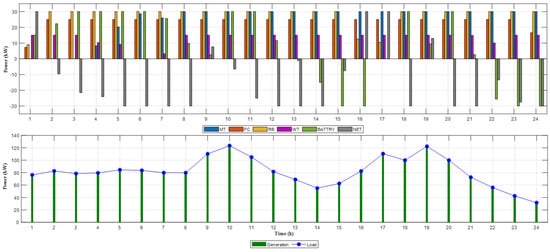
Figure 8.
Optimal management of electrical elements of the micro-grid.
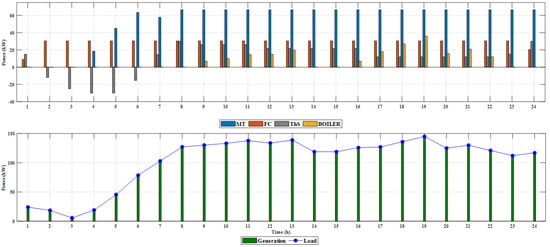
Figure 9.
Optimal management of thermal elements of the micro-grid.

Table 2.
Results of the proposed MCS-based method and centralized method.
7. Conclusions
In this study, an applied method for optimal management of the performance of an MEMG is presented, considering the uncertainties associated with the prediction of daily demand. The agents of the energy system are at three decentralized levels, and are interrelated at these levels. The equations are formulated according to the relationships between agents at these three levels.
The proposed method was tested on an MEMG. The results indicate a reduction in operational network costs and the complexity of computations compared to centralized methods. On the other hand, linearization of equations was carried out. This linearization can reduce the computational complexity of the proposed method.
Therefore, energy management systems with an MCS-based modeling approach are a suitable solution for optimal energy management and reducing the demand of micro-consumers (urban buildings) from upstream networks, electricity, and natural gas networks, reducing greenhouse gas emissions. In future work, the design of an MG should be considered so that the MG can make operational decisions that affect the market price.
Author Contributions
Conceptualization, S.S.; methodology, M.F. and S.S.; software, M.F.; validation, M.K. and T.S.; formal analysis, S.S. and A.N.; investigation, M.K.; resources, A.N.; data curation, M.F. and S.S.; writing—original draft preparation, M.F.; writing—review and editing, A.N. and M.K.; visualization, S.S.; supervision, A.N. and T.S.; funding acquisition, A.N. All authors have read and agreed to the published version of the manuscript.
Funding
This research received no external funding.
Institutional Review Board Statement
Not applicable.
Informed Consent Statement
Not applicable.
Data Availability Statement
Publicly available datasets were analyzed in this study. This data can be found here: [http://www.ieso.ca/power-data] (8 January 2022), [http://climate.weather.gc.ca/historicaldata/searchhistoricdatae.html] (8 January 2022).
Conflicts of Interest
The authors declare no conflict of interest.
Abbreviations
| Cost of power exchange | Fuel consumption of micro-turbine | ||
| Exchanged power | Constant that relates PT and PTT | ||
| Price of power exchange | Boiler efficiency | ||
| Electrical power of micro-turbine | Fuel consumption of boiler | ||
| Electrical power of waste power plant | Price of natural gas | ||
| Electrical power of wind turbine | Status of micro-turbine (0 or 1) | ||
| Electrical AC power of inverter | Price of micro-turbine O&M | ||
| Electrical AC power of rectifier | Start/stop rate of micro-turbine | ||
| Electrical power demand | Emission rate of micro-turbine | ||
| Thermal power of micro-turbine | Emission rate of boiler | ||
| Thermal power of fuel cell | Fuel cell efficiency | ||
| Thermal power of boiler | Reformer efficiency | ||
| Charging/discharging of thermal storage | Higher heating value of methane | ||
| Thermal power demand | Fuel consumption of fuel cell | ||
| Emissions of micro-turbine | Constant that relates PFC and PTFC | ||
| Emissions of fuel cell | Quantity of electrical storage | ||
| Emissions of waste power plant | Charging energy of electrical storage | ||
| Emissions of boiler | Discharging energy of electrical storage | ||
| Fuel cost of micro-turbine | Data vector of cell block, forget, and input gates at time t | ||
| O&M cost of micro-turbine | Bias vector for cell block, forget, input, and output gates | ||
| Start/stop cost of micro-turbine | Data vector of output gate at time t | ||
| Fuel cost of fuel cell | State vector of current layer at state t | ||
| O&M cost of fuel cell | State vector of layer l at state t | ||
| Start/stop cost of fuel cell | Weight vector for output of previous state input gate, forget gate, cell block, and output gate | ||
| Fuel cost of waste power plant | Weight vector for input of current state input gate, forget gate, cell block, and output gate | ||
| O&M cost of waste power plant | Period of time | ||
| Start/Stop cost of waste power plant | Status of boiler (0 or 1) | ||
| O&M cost of wind turbine | Amount of stored hydrogen | ||
| O&M cost of thermal storage | Charging/discharging output of the HT | ||
| O&M cost of hydrogen tank | Electrical DC power of inverter | ||
| O&M cost of electrical storage | Electrical DC power of rectifier | ||
| Micro-turbine efficiency | Inverter efficiency | ||
| Higher heating value of gas | Rectifier efficiency |
References
- Li, Y.; Liang, W.; Tan, R. Optimal design of installation capacity and operation strategy for distributed energy system. Appl. Therm. Eng. 2017, 125, 756–766. [Google Scholar] [CrossRef]
- Allison, J. Robust multi-objective control of hybrid renewable microgeneration systems with energy storage. Appl. Therm. Eng. 2017, 114, 1498–1506. [Google Scholar] [CrossRef] [Green Version]
- Mohseni, S.; Moghaddas-Tafreshi, S.M. A multi-agent system for optimal sizing of a cooperative self-sustainable multi-carrier microgrid. Sustain. Cities Soc. 2018, 38, 452–465. [Google Scholar] [CrossRef]
- Väisänen, S.; Mikkilä, M.; Havukainen, J.; Sokka, L.; Luoranen, M.; Horttanainen, M. Using a multi-method approach for decision-making about a sustainable local distributed energy system: A case study from Finland. J. Clean. Prod. 2016, 137, 1330–1338. [Google Scholar] [CrossRef]
- Yang, G.; Zhai, X. Optimization and performance analysis of solar hybrid CCHP systems under different operation strategies. Appl. Therm. Eng. 2018, 133, 327–340. [Google Scholar] [CrossRef]
- Luo, Z.; Wu, Z.; Li, Z.; Cai, H.; Li, B.; Gu, W. A two-stage optimization and control for CCHP microgrid energy management. Appl. Therm. Eng. 2017, 125, 513–522. [Google Scholar] [CrossRef]
- Kumar, K.P.; Saravanan, B. Recent techniques to model uncertainties in power generation from renewable energy sources and loads in microgrids–A review. Renew. Sustain. Energy Rev. 2017, 71, 348–358. [Google Scholar] [CrossRef]
- Melamed, M.; Ben-Tal, A.; Golany, B. A multi-period unit commitment problem under a new hybrid uncertainty set for a renewable energy source. Renew. Energy 2018, 118, 909–917. [Google Scholar] [CrossRef]
- Bernal-Agustín, J.L.; Dufo-Lopez, R. Simulation and optimization of stand-alone hybrid renewable energy systems. Renew. Sustain. Energy Rev. 2009, 13, 2111–2118. [Google Scholar] [CrossRef]
- Van Roy, J.; Leemput, N.; Geth, F.; Büscher, J.; Salenbien, R.; Driesen, J. Electric vehicle charging in an office building microgrid with distributed energy resources. IEEE Trans. Sustain. Energy 2014, 5, 1389–1396. [Google Scholar] [CrossRef]
- Lasseter, R.; Akhil, A.; Marnay, C.; Stephens, J.; Dagle, J.; Guttromsom, R.; Meliopoulous, A.S.; Yinger, R.; Eto, J. Integration of distributed energy resources. In The CERTS Microgrid Concept; No. LBNL-50829; Lawrence Berkeley National Lab.(LBNL): Berkeley, CA, USA, 2002. [Google Scholar]
- Nazari-Heris, M.; Abapour, S.; Mohammadi-Ivatloo, B. Optimal economic dispatch of FC-CHP based heat and power micro-grids. Appl. Therm. Eng. 2017, 114, 756–769. [Google Scholar] [CrossRef]
- Prinsloo, G.; Dobson, R.; Mammoli, A. Synthesis of an intelligent rural village microgrid control strategy based on smartgrid multi-agent modelling and transactive energy management principles. Energy 2018, 147, 263–278. [Google Scholar] [CrossRef]
- Malekpour, A.R.; Pahwa, A. Stochastic networked microgrid energy management with correlated wind generators. IEEE Trans. Power Syst. 2017, 32, 3681–3693. [Google Scholar] [CrossRef]
- Afrasiabi, M.; Mohammadi, M.; Rastegar, M.; Kargarian, A. Multi-agent microgrid energy management based on deep learning forecaster. Energy 2019, 186, 115873. [Google Scholar] [CrossRef]
- Elsied, M.; Oukaour, A.; Gualous, H.; Brutto, O.A.L. Optimal economic and environment operation of micro-grid power systems. Energy Convers. Manag. 2016, 122, 182–194. [Google Scholar] [CrossRef]
- Niknam, T.; Golestaneh, F.; Malekpour, A. Probabilistic energy and operation management of a microgrid containing wind/photovoltaic/fuel cell generation and energy storage devices based on point estimate method and self-adaptive gravitational search algorithm. Energy 2012, 43, 427–437. [Google Scholar] [CrossRef]
- Hussain, A.; Bui, V.H.; Kim, H.M. Optimal operation of hybrid microgrids for enhancing resiliency considering feasible islanding and survivability. IET Renew. Power Gener. 2017, 11, 846–857. [Google Scholar] [CrossRef]
- Mohammadi, S.; Soleymani, S.; Mozafari, B. Scenario-based stochastic operation management of microgrid including wind, photovoltaic, micro-turbine, fuel cell and energy storage devices. Int. J. Electr. Power Energy Syst. 2014, 54, 525–535. [Google Scholar] [CrossRef]
- Nikmehr, N.; Najafi-Ravadanegh, S.; Khodaei, A. Probabilistic optimal scheduling of networked microgrids considering time-based demand response programs under uncertainty. Appl. Energy 2017, 198, 267–279. [Google Scholar] [CrossRef]
- Bracco, S.; Delfino, F.; Pampararo, F.; Robba, M.; Rossi, M. A mathematical model for the optimal operation of the University of Genoa Smart Polygeneration Microgrid: Evaluation of technical, economic and environmental performance indicators. Energy 2014, 64, 912–922. [Google Scholar] [CrossRef]
- Bracco, S.; Brignone, M.; Delfino, F.; Pampararo, F.; Rossi, M.; Ferro, G.; Robba, M. An optimization model for polygeneration microgrids with renewables, electrical and thermal storage: Application to the savona campus. In 2018 IEEE International Conference on Environment and Electrical Engineering and 2018 IEEE Industrial and Commercial Power Systems Europe (EEEIC/I&CPS Europe); IEEE: Piscataway Township, NJ, USA, 2018; pp. 1–6. [Google Scholar]
- Urbanucci, L.; Testi, D.; Bruno, J.C. An operational optimization method for a complex polygeneration plant based on real-time measurements. Energy Convers. Manag. 2018, 170, 50–61. [Google Scholar] [CrossRef]
- Sigarchian, S.G.; Malmquist, A.; Martin, V. The choice of operating strategy for a complex polygeneration system: A case study for a residential building in Italy. Energy Convers. Manag. 2018, 163, 278–291. [Google Scholar] [CrossRef]
- La Scala, M.; Vaccaro, A.; Zobaa, A.F. A goal programming methodology for multiobjective optimization of distributed energy hubs operation. Appl. Therm. Eng. 2014, 71, 658–666. [Google Scholar] [CrossRef] [Green Version]
- Kampouropoulos, K.; Andrade, F.; Sala, E.; Espinosa, A.G.; Romeral, L. Multiobjective optimization of multi-carrier energy system using a combination of ANFIS and genetic algorithms. IEEE Trans. Smart Grid 2016, 9, 2276–2283. [Google Scholar] [CrossRef] [Green Version]
- Karavas, C.S.; Kyriakarakos, G.; Arvanitis, K.G.; Papadakis, G. A multi-agent decentralized energy management system based on distributed intelligence for the design and control of autonomous polygeneration microgrids. Energy Convers. Manag. 2015, 103, 166–179. [Google Scholar] [CrossRef]
- Karavas, C.S.; Arvanitis, K.; Papadakis, G. A game theory approach to multi-agent decentralized energy management of autonomous polygeneration microgrids. Energies 2017, 10, 1756. [Google Scholar] [CrossRef] [Green Version]
- Wasilewski, J. Optimisation of multicarrier microgrid layout using selected metaheuristics. Int. J. Electr. Power Energy Syst. 2018, 99, 246–260. [Google Scholar] [CrossRef]
- Roustai, M.; Rayati, M.; Sheikhi, A.; Ranjbar, A. A scenario-based optimization of Smart Energy Hub operation in a stochastic environment using conditional-value-at-risk. Sustain. Cities Soc. 2018, 39, 309–316. [Google Scholar] [CrossRef]
- Giaouris, D.; Papadopoulos, A.I.; Patsios, C.; Walker, S.; Ziogou, C.; Taylor, P.; Voutetakis, S.; Papadopoulou, S.; Seferlis, P. A systems approach for management of microgrids considering multiple energy carriers, stochastic loads, forecasting and demand side response. Appl. Energy 2018, 226, 546–559. [Google Scholar] [CrossRef] [Green Version]
- Zhang, J.; Wang, X.; Ma, L. An optimal power allocation scheme of microgrid using grey wolf optimizer. IEEE Access 2019, 7, 137608–137619. [Google Scholar] [CrossRef]
- Mishra, S.; Bordin, C.; Tomasgard, A.; Palu, I. A multi-agent system approach for optimal microgrid expansion planning under uncertainty. Int. J. Electr. Power Energy Syst. 2019, 109, 696–709. [Google Scholar] [CrossRef]
- Samadi, E.; Badri, A.; Ebrahimpour, R. Decentralized multi-agent based energy management of microgrid using reinforcement learning. Int. J. Electr. Power Energy Syst. 2020, 122, 106211. [Google Scholar] [CrossRef]
- Jin, S.; Wang, S.; Fang, F. Game theoretical analysis on capacity configuration for microgrid based on multi-agent system. Int. J. Electr. Power Energy Syst. 2021, 125, 106485. [Google Scholar] [CrossRef]
- Jahangir, H.; Gougheri, S.S.; Vatandoust, B.; Golkar, M.A.; Golkar, M.A.; Ahmadian, A.; Hajizadeh, A. A Novel Cross-Case Electric Vehicle Demand Modeling Based on 3D Convolutional Generative Adversarial Networks. IEEE Trans. Power Syst. 2021, 37, 1173–1183. [Google Scholar] [CrossRef]
- Jahangir, H.; Tayarani, H.; Gougheri, S.S.; Golkar, M.A.; Ahmadian, A.; Elkamel, A. Deep Learning-Based Forecasting Approach in Smart Grids With Microclustering and Bidirectional LSTM Network. IEEE Trans. Ind. Electron. 2020, 68, 8298–8309. [Google Scholar] [CrossRef]
- Sadeghi, S.; Jahangir, H.; Vatandoust, B.; Golkar, M.A.; Ahmadian, A.; Elkamel, A. Optimal bidding strategy of a virtual power plant in day-ahead energy and frequency regulation markets: A deep learning-based approach. Int. J. Electr. Power Energy Syst. 2021, 127, 106646. [Google Scholar] [CrossRef]
- Jahangir, H.; Tayarani, H.; Ahmadian, A.; Golkar, M.A.; Miret, J.; Tayarani, M.; Gao, H.O. Charging demand of plug-in electric vehicles: Forecasting travel behavior based on a novel rough artificial neural network approach. J. Clean. Prod. 2019, 229, 1029–1044. [Google Scholar] [CrossRef]
- Khodayar, M.; Wang, J. Spatio-temporal graph deep neural network for short-term wind speed forecasting. IEEE Trans. Sustain. Energy 2018, 10, 670–681. [Google Scholar] [CrossRef]
- Gougheri, S.S.; Jahangir, H.; Golkar, M.A.; Ahmadian, A.; Golkar, M.A. Optimal participation of a virtual power plant in electricity market considering renewable energy: A deep learning-based approach. Sustain. Energy Grids Netw. 2021, 26, 100448. [Google Scholar] [CrossRef]
- Norouzi, N.; Tavakkoli-Moghaddam, R.; Ghazanfari, M.; Alinaghian, M.; Salamatbakhsh, A. A new multi-objective competitive open vehicle routing problem solved by particle swarm optimization. Netw. Spat. Econ. 2012, 12, 609–633. [Google Scholar] [CrossRef]
- Glover, F.; Woolsey, E. Converting the 0–1 polynomial programming problem to a 0–1 linear program. Oper. Res. 1974, 22, 180–182. [Google Scholar] [CrossRef] [Green Version]
- Soroudi, A. Power System Optimization Modeling in GAMS; Springer: Berlin/Heidelberg, Germany, 2017. [Google Scholar]
- Power Data. Available online: http://www.ieso.ca/power-data (accessed on 20 May 2021).
- Renewable Energy Policy Network for the 21st Century. Available online: http://climate.weather.gc.ca/historicaldata/searchhistoricdatae.html (accessed on 20 May 2021).
- Moghaddam, A.A.; Seifi, A.; Niknam, T.; Pahlavani, M.R.A. Multi-objective operation management of a renewable MG (micro-grid) with back-up micro-turbine/fuel cell/battery hybrid power source. Energy 2011, 36, 6490–6507. [Google Scholar] [CrossRef]
- Zhang, L.; Xiang, J. The performance of a grid-tied microgrid with hydrogen storage and a hydrogen fuel cell stack. Energy Convers. Manag. 2014, 87, 421–427. [Google Scholar] [CrossRef]
Publisher’s Note: MDPI stays neutral with regard to jurisdictional claims in published maps and institutional affiliations. |
© 2022 by the authors. Licensee MDPI, Basel, Switzerland. This article is an open access article distributed under the terms and conditions of the Creative Commons Attribution (CC BY) license (https://creativecommons.org/licenses/by/4.0/).